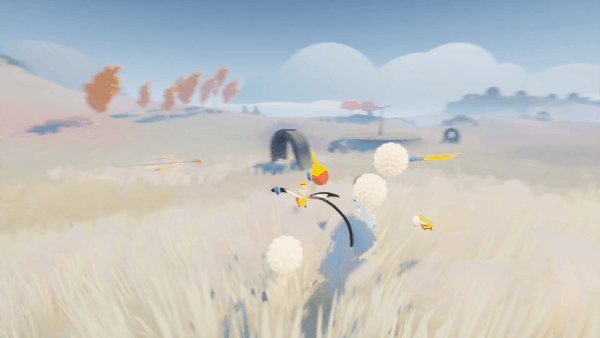Trending
Opinion: How will Project 2025 impact game developers?
The Heritage Foundation's manifesto for the possible next administration could do great harm to many, including large portions of the game development community.

Nestled among the plethora of curious creatures that players can collect in Flock is one particular resident that will feel immediately familiar: the humble sheep.
When they're not rounding up a cloud of floating familiars, players will need to tend to a herd of wooly sausages that are worth their weight in gold.
That's because, in Flock's effervescent world, wool is the hottest of commodities. It can be traded for cosmetic items like hats and scarves that will turn your bird-riding shepherd into a fashion icon. These are, as you can imagine, absolutely essential.
To collect wool, you'll need to find grazing spots where your hungry herd can munch the days away—and perhaps even reveal a few secrets. During a recent chat with creative director Ricky Haggett and programmer Mike Robinson, we learned that although sheep were always envisioned as part of the game, the mechanic morphed a lot during development.
Initially, sheep were pitched as weird creatures called "ongles, gongles, and bongles." They were strange pink oddities that could be sheared for different resources, but it was a pitch that immediately felt too complex. At that stage, different variants of those sheep-like creatures would produce unique resources such as feathers or wool. Players could use those to craft different items, but it felt a lot like busywork. "There was more breadth [at that stage]," says Haggett, who concedes there was also more "guff."
For a long time, players also had to keep track of their herds. There were no markers on the map, and the singing mechanic that lets players locate their bleating friends hadn't been added. It was a system that, in Haggett's own words, created a lot of "oh fuck" moments when players realized they had lost their livestock and had no way of finding them without scouring the entire map.
That complexity began to fall away when the Hollow Ponds team realized they had to create a "symbiosis" between exploring a huge sprawling world and finding a sense of purpose. It became clear that striking that balance didn't require a hugely complex crafting system or textile economy, but rather a mechanic that could anchor players without feeling overbearing.

For example, at one point Flock featured a lost sheep system that would effectively punish players for misplacing their baa-rmy pals. "We got rid of it because it just felt [wrong]," says Haggett. "Over time we just streamlined the process of the sheep and became a lot more chill about it."
As the mechanic was fine-tuned, the team also acknowledged that obscuring the fact Flock's ongles and bongles were essentially sheep was somewhat ludicrous. "There was a point where we were just like 'these are sheep. Let's just make them sheep and have wool.' And wool is nice because you can knit things out of wool," says Haggett.
The finishing touch eventually came in the form of meadows. These are designated spots where players can drop sheep so they can graze (generating wool in the process). You can't just plonk sheep anywhere, so pushing players to find meadows adds another layer to exploration. It also presented an opportunity for one last twist. "The other thing that massively changed with the meadow came quite late in development was the Burgling Bewl," explains Haggett.
For the uninitiated, 'Burgling Bewls' are pesky creatures that hide in meadows and can only be yanked from their hidey hole once sheep have trimmed the grass. Apprehending Burgling Bewls unlocks new whistles, which teach songs that can be used to charm different species so they can be recruited to your flock.
It was, for Haggett, a stroke of subtle genius that finally made the sheep make sense. "[Writer and narrative designer] Phillippa Warr was one of the people who spent ages trying to figure out how to better tie the sheep into the game," he says. "For a long time, the sheep were almost this separate thing—and a couple of times we were like 'should we just cut the sheep?' Because they were just this weird way of getting clothes.
.jpg?width=700&auto=webp&quality=80&disable=upscale)
"For a while, we had this convoluted system where you had to feed the sheep, get wool, then you could find song stones for different species, then you'd need to find a bird trainer to teach you songs, and you'd have to pay them in wool. It was this multi-tiered system where you needed the sheep so you could get wool, so you could pay the bird trainer to teach you the songs–but only after you'd found all the stones."
It was an disjointed system that felt impossible to tutorialize, so hitting upon the idea of concealing Burgling Bewls into meadows was akin the striking gold. "Effectively what it is [now] is like finding a treasure chest in Zelda and getting a reward. [...] It's a bit of a skinner box where you wait for the bar to fill up and then get a prize," says Haggett. He admits to being concerned it might feel a bit "cheap," but says it solved so many design problems "so elegantly" that, ultimately, it stuck.
Read more about:
Top StoriesYou May Also Like